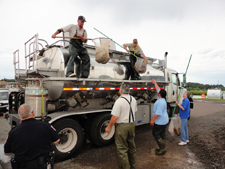Other Fisheries Projects
Retired Lake Trout (Chinamekos) Stocking
 In mid-June of 2012 KBIC NRD staff, community members and summer youth crew workers had the opportunity to assist in the release of over 600 retired brood stock lake trout from the Iron River National Fish Hatchery (NFH) of Wisconsin. The fish were 10 or 12 years of age and the average weight was 12-13lbs per individual fish. According to the USFWS, these fish, which are Lake Superior Apostle Island strain, were no longer needed as brood stock based on changes in stocking strategies for the Upper Great Lakes. New brood stock for the Upper Great Lakes will come from Lake Huron. According to KBIC NRD Fisheries and Wildlife Biologist, Gene Mensch, “several options were explored regarding destinations and management uses for these fish. Ultimately it was decided that Keweenaw Bay stocking would serve the dual purpose of providing an enhancement to local fishing opportunities while also allowing these fish to return to the system they were derived from.”
In mid-June of 2012 KBIC NRD staff, community members and summer youth crew workers had the opportunity to assist in the release of over 600 retired brood stock lake trout from the Iron River National Fish Hatchery (NFH) of Wisconsin. The fish were 10 or 12 years of age and the average weight was 12-13lbs per individual fish. According to the USFWS, these fish, which are Lake Superior Apostle Island strain, were no longer needed as brood stock based on changes in stocking strategies for the Upper Great Lakes. New brood stock for the Upper Great Lakes will come from Lake Huron. According to KBIC NRD Fisheries and Wildlife Biologist, Gene Mensch, “several options were explored regarding destinations and management uses for these fish. Ultimately it was decided that Keweenaw Bay stocking would serve the dual purpose of providing an enhancement to local fishing opportunities while also allowing these fish to return to the system they were derived from.”
 The fish are safe for consumption and several anglers have reported that the fish are “high quality for the table.” All fish were double fin-clipped (adipose and left pectoral) and approximately 50% of the fish were floy tagged (KBIC-BLUE research tags). Anglers capturing a tagged lake trout can remove the tag and mail it to the KBIC NRD to receive a small reward and information about the fish (14359 Pequaming Road, L’Anse, MI 49946). If you choose to release the fish, you can right down the tag number and call it in to (906) 524-8200.
The fish are safe for consumption and several anglers have reported that the fish are “high quality for the table.” All fish were double fin-clipped (adipose and left pectoral) and approximately 50% of the fish were floy tagged (KBIC-BLUE research tags). Anglers capturing a tagged lake trout can remove the tag and mail it to the KBIC NRD to receive a small reward and information about the fish (14359 Pequaming Road, L’Anse, MI 49946). If you choose to release the fish, you can right down the tag number and call it in to (906) 524-8200.
Creating Fish Habitat
In winter of 2011-12, KBIC (Natural Resources Department staff) assisted Ottawa National Forest (ONF), Michigan Department of Natural Resources (MDNR) and volunteers in constructing and placing large woody debris fish structures on a lake in the Ottawa National Forest near Watersmeet. The small lake was determined by fisheries biologists to be a good candidate lake for fish structure and habitat work. Ten fish "cribs" were built and placed strategically in clusters of 5 on ice that was over a foot thick. The structures were tethered with nearly a half a ton of sand bags (each), and with spring thaw and thinning ice, it is hoped they will collapse through the surface ice and sink to the lake bottom at or near their placement locations. Large woody debris deposits on lake bottoms provide shelter for young fish, spawning habitat for certain fish species and are proven to increase fish abundance and survival when properly constructed and positioned. Similar future work is anticipated on various lakes in the western Upper Peninsula, and KBNRD will continue to partner with other agencies in enhancing throughout the region.
Fish Passage Improvement Projects
 With GLRI support, the KBIC (NRD and Public Works) is working with USDA-NRCS and the Baraga County Road Commission (BCRC) to improve the health of several stream systems in and around the Reservation by installing culverts or bridges that allow passage of aquatic organisms upstream and downstream. Road culverts are improved by replacing those that are either too small or perched above the river bottom, thus impeding fish passage and proper water flow. Two of the twelve fish passage improvement projects were completed in 2012; one at Gomanche Creek crossing on Indian Road and the other at the Falls River crossing on Golf Course Road. Four more of the twelve culvert replacements are planned for completion in 2013.
With GLRI support, the KBIC (NRD and Public Works) is working with USDA-NRCS and the Baraga County Road Commission (BCRC) to improve the health of several stream systems in and around the Reservation by installing culverts or bridges that allow passage of aquatic organisms upstream and downstream. Road culverts are improved by replacing those that are either too small or perched above the river bottom, thus impeding fish passage and proper water flow. Two of the twelve fish passage improvement projects were completed in 2012; one at Gomanche Creek crossing on Indian Road and the other at the Falls River crossing on Golf Course Road. Four more of the twelve culvert replacements are planned for completion in 2013.

